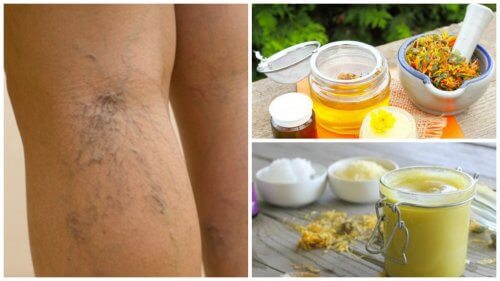How to Use Arnica Ointment to Treat Varicose Veins


Reviewed and approved by the doctor Karla Henríquez
Arnica ointment is one of the most popular natural remedies to exist. It’s important to note that there’s no evidence that it helps reduce varicose veins in the skin. However, it does appear to be useful in relieving uncomfortable symptoms like swelling and heaviness in the legs.
Varicose veins are usually the result of a problem in the circulatory system. This dilates the veins and capillaries, almost always in the lower extremities.
Varicose and spider veins usually have a reddish or bruised color and are often quite noticeable on the skin, as they cause swelling. They usually develop on the calves and the inner part of the thighs. However, they can also appear on other parts of the body.
Most women begin to suffer from this condition during pregnancy, or from the age of 50, due to the hormonal changes that the body experiences.
Regardless of the cause, those who develop varicose or spider veins seek to minimize their appearance. This is not only because they affect the appearance of their legs, but also because they can cause swelling and pain.
Arnica ointment to minimize varicose veins and spider veins
According to a study published in 2014, evidence and data from several researchers indicated that “the medicinal use of arnica is thanks to its characteristics as an astringent […] what’s more, it relieves pain, acts as an anti-inflammatory, and is useful in bacterial and fungal infections.”
In the realm of phototherapy, arnica ointment is said to have antiinflammatory and calming properties. Therefore, it helps reduce the discomfort that results from varicose veins and spider veins. At the same time, it also calms bruises, pains, sprains, and even insect bites.
With this in mind, it may be beneficial to apply reasonable amounts via lymphatic massage. In doing so, you’ll take maximum advantage of its benefits.

Ingredients
- 2 tablespoons of beeswax
- 2 tablespoons shea butter
- 1 tablespoon of almond oil
- 2 tablespoons of arnica oil
- And, finally, 1 vitamin E capsule
Method
- First, melt the beeswax in the double boiler.
- When it melts, add the shea butter and the almond oil.
- After that, turn down the heat to minimum, and stir with a silicone utensil until it’s all well mixed.
- When the mixture’s ready, remove it from the heat.
- After this, immediately add the arnica oil and vitamin E capsule.
- Allow it to stand for a few minutes and pour it into an airtight glass jar before it solidifies.
How to apply it
- First, take the necessary amount of the product and massage it into the affected areas
- Let it absorb into your skin
- Apply it every night
- However, you shouldn’t use it on cuts or open lesions
- If you have atopic dermatitis, sensitive skin, or some other skin condition, consult with your doctor before applying arnica ointment or any other similar remedy to avoid adverse reactions.
- Don’t mix this ointment with any other creams or preparations, as the possible effects are unknown.
What do you need to know about arnica oinment?

This arnica ointment can be a good way to relieve discomfort in the legs. Just the same, it’s important to keep in mind that, on it’s own, it’s not a solution for any health issue.
No home remedy can substitute the treatment your doctor recommends. Therefore, you should always follow your doctor’s instructions and consider this ointment to be a complementary remedy.
It’s important to note that, if you suffer from sensitive skin, atopic dermatitis, of any other skin problem, you should check with your dermatologist before applying. This way, you’ll be able to avoid any adverse reactions.
What else can I do to reduce discomfort?

Besides applying arnica ointment, you should also maintain healthy lifestyle habits. For example, follow a balanced diet and a good exercise routine. All of this will help you feel better.
Walk every day for at least 20 to 40 minutes and practice yoga or some other sport of your choice. There are many ways to stay active… You just need to find what suits you best and makes you feel better. Have your tried zumba or anything else? Give them a try!
When resting, elevate your legs for a while to ease your legs and experience greater relief. Remember to place a pillow below your legs when sleeping.
All cited sources were thoroughly reviewed by our team to ensure their quality, reliability, currency, and validity. The bibliography of this article was considered reliable and of academic or scientific accuracy.
- Brito, N., Knipschild, P., & Doreste-Alonso, J. (2014). Systematic review on the efficacy of topicalArnica montanafor the treatment of pain, swelling and bruises. Journal of Musculoskeletal Pain, 22(2), 216–223. https://www.tandfonline.com/doi/abs/10.3109/10582452.2014.883012
- Kawakami, A. P., Sato, C., Cardoso, T. N., & Bonamin, L. V. (2011). Inflammatory Process Modulation by Homeopathic Arnica montana 6CH: The Role of Individual Variation. Evidence-Based Complementary and Alternative Medicine : eCAM, 2011, 917541. https://www.ncbi.nlm.nih.gov/pmc/articles/PMC3035003/
- Kriplani, P., Guarve, K., & Baghael, U. S. (2017). Arnica montana L. – a plant of healing: review. The Journal of Pharmacy and Pharmacology, 69(8), 925–945. https://onlinelibrary.wiley.com/doi/10.1111/jphp.12724
- Röhrl, J., Piqué-Borràs, M.-R., Jaklin, M., Werner, M., Werz, O., Josef, H., Hölz, H., Ammendola, A., & Künstle, G. (2023). Anti-inflammatory activities of Arnica montana planta Tota versus flower extracts: Analytical, in vitro and in vivo mouse paw oedema model studies. Plants, 12(6), 1348. https://www.mdpi.com/2223-7747/12/6/1348
- The Vein Institute. (28 de febrero de 2021). Non-medical options for managing varicose veins. https://www.theveininstitute.com.au/non-medical-options-for-managing-varicose-veins/
- Waizel, B, J., & Cruz, J. M. (2014). Arnica montana L., relevant European medicinal plant. Revista Mexicana de Ciencias Forestales, 5(25), 98–109. https://www.scielo.org.mx/scielo.php?pid=S2007-11322014000500008&script=sci_abstract&tlng=en
This text is provided for informational purposes only and does not replace consultation with a professional. If in doubt, consult your specialist.








